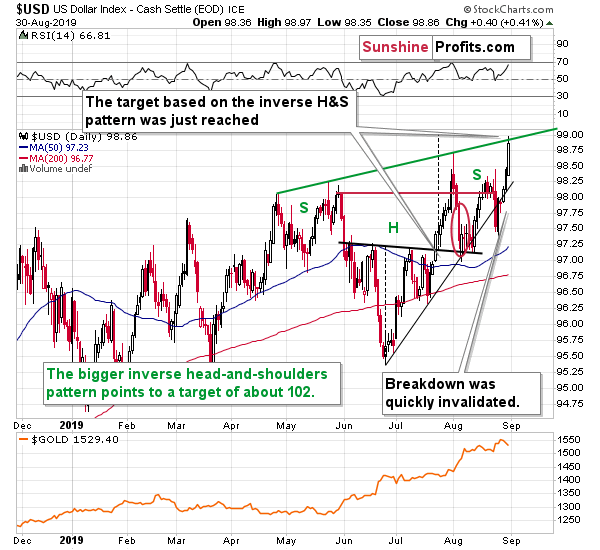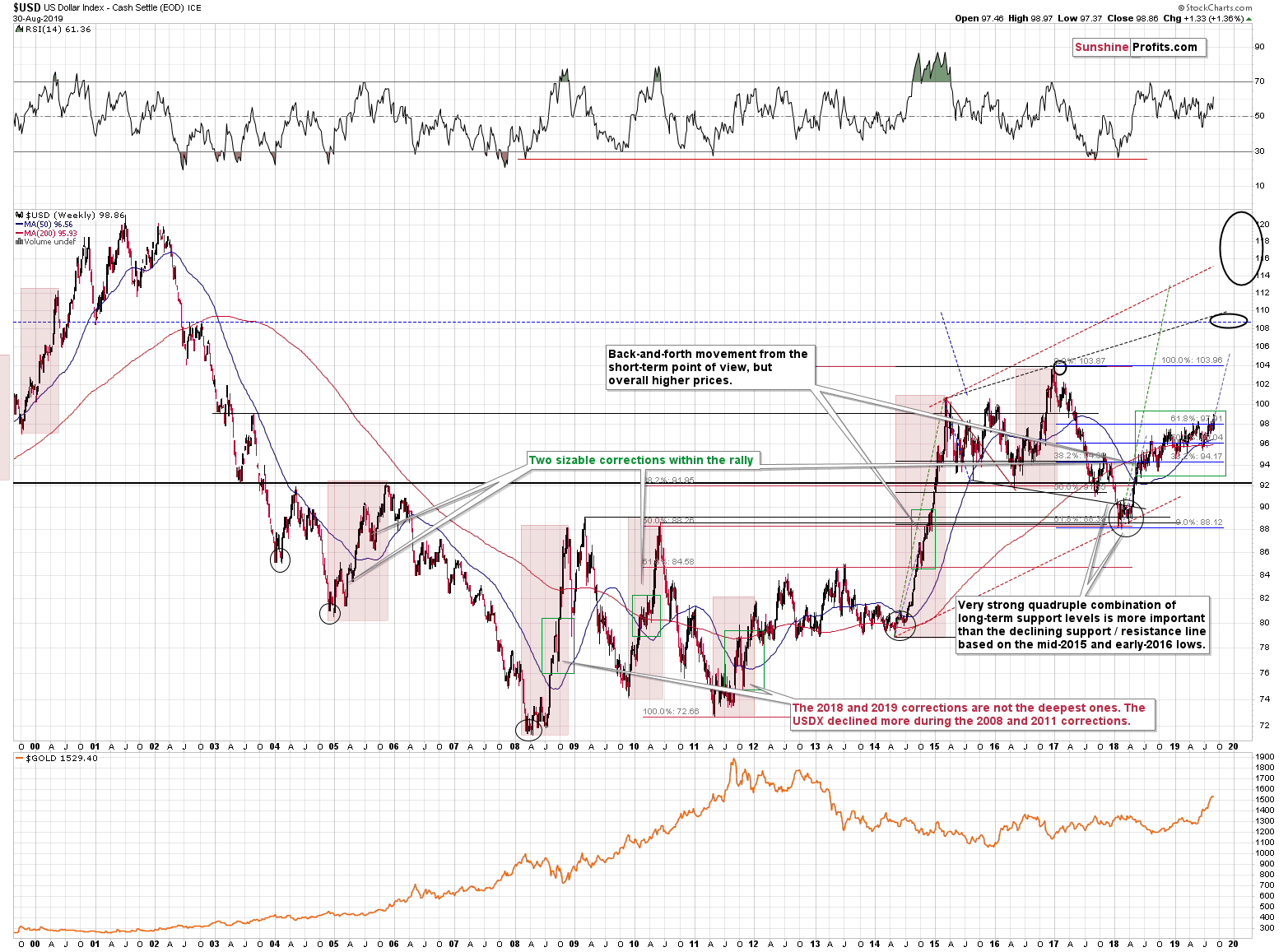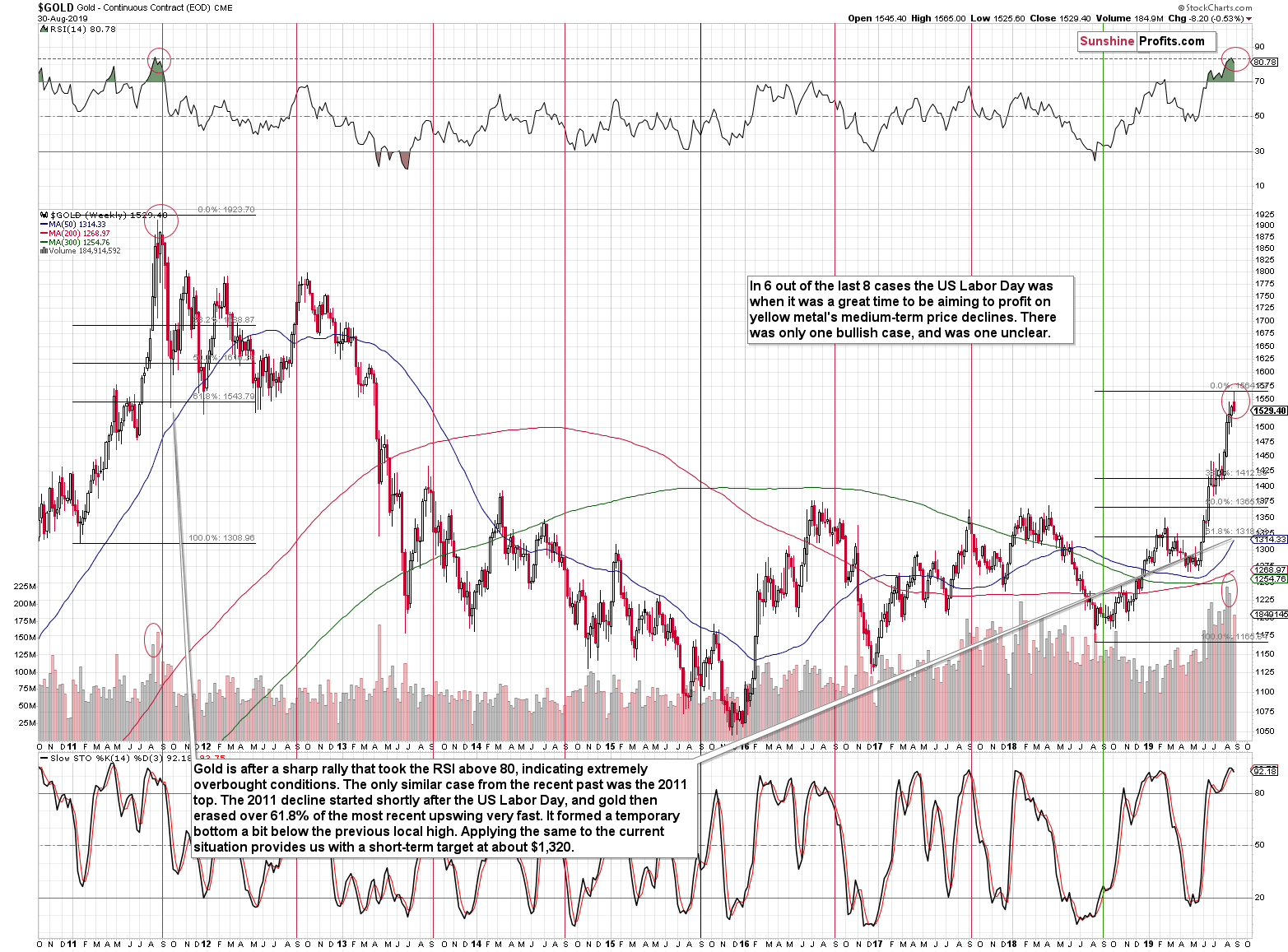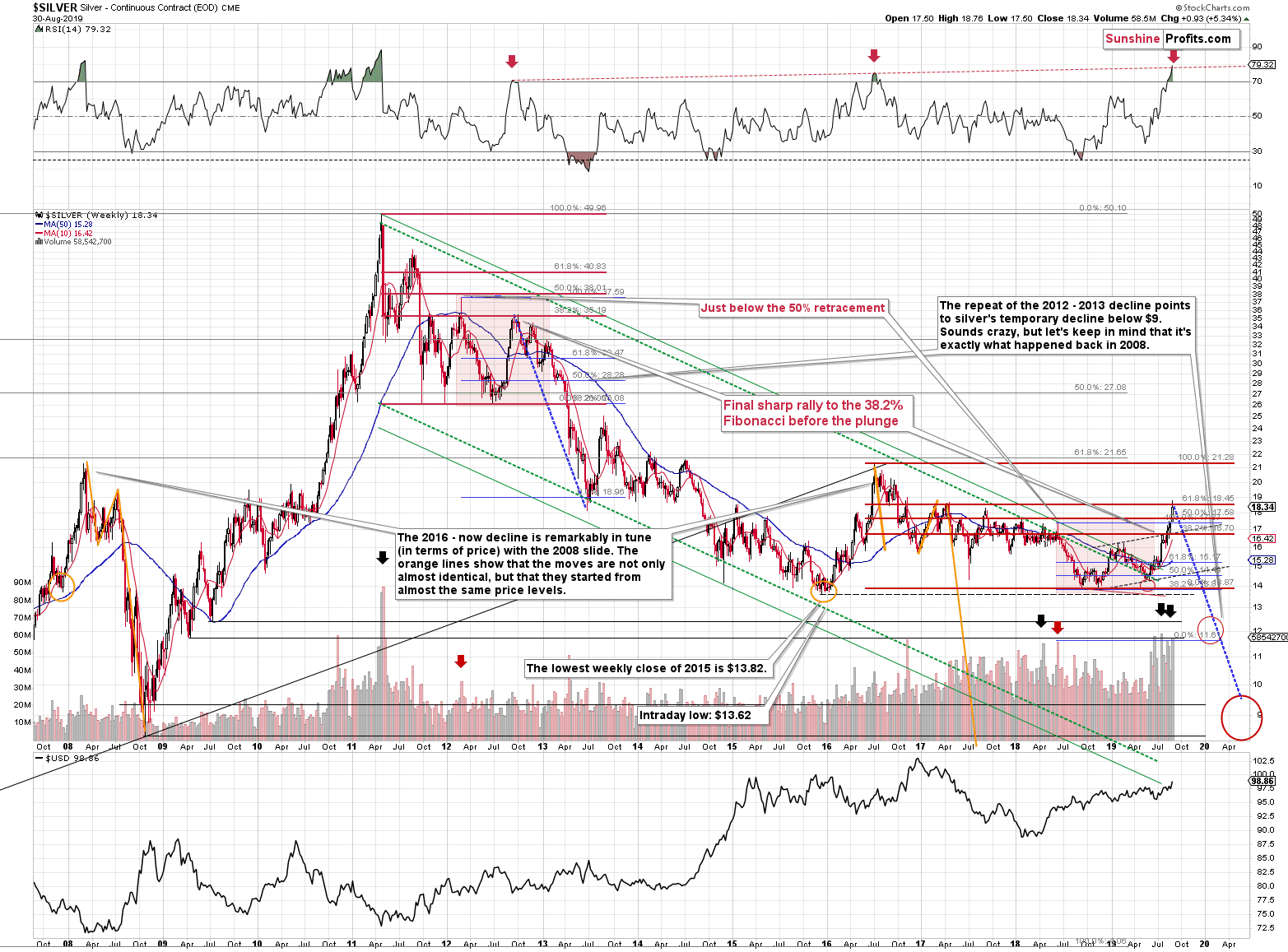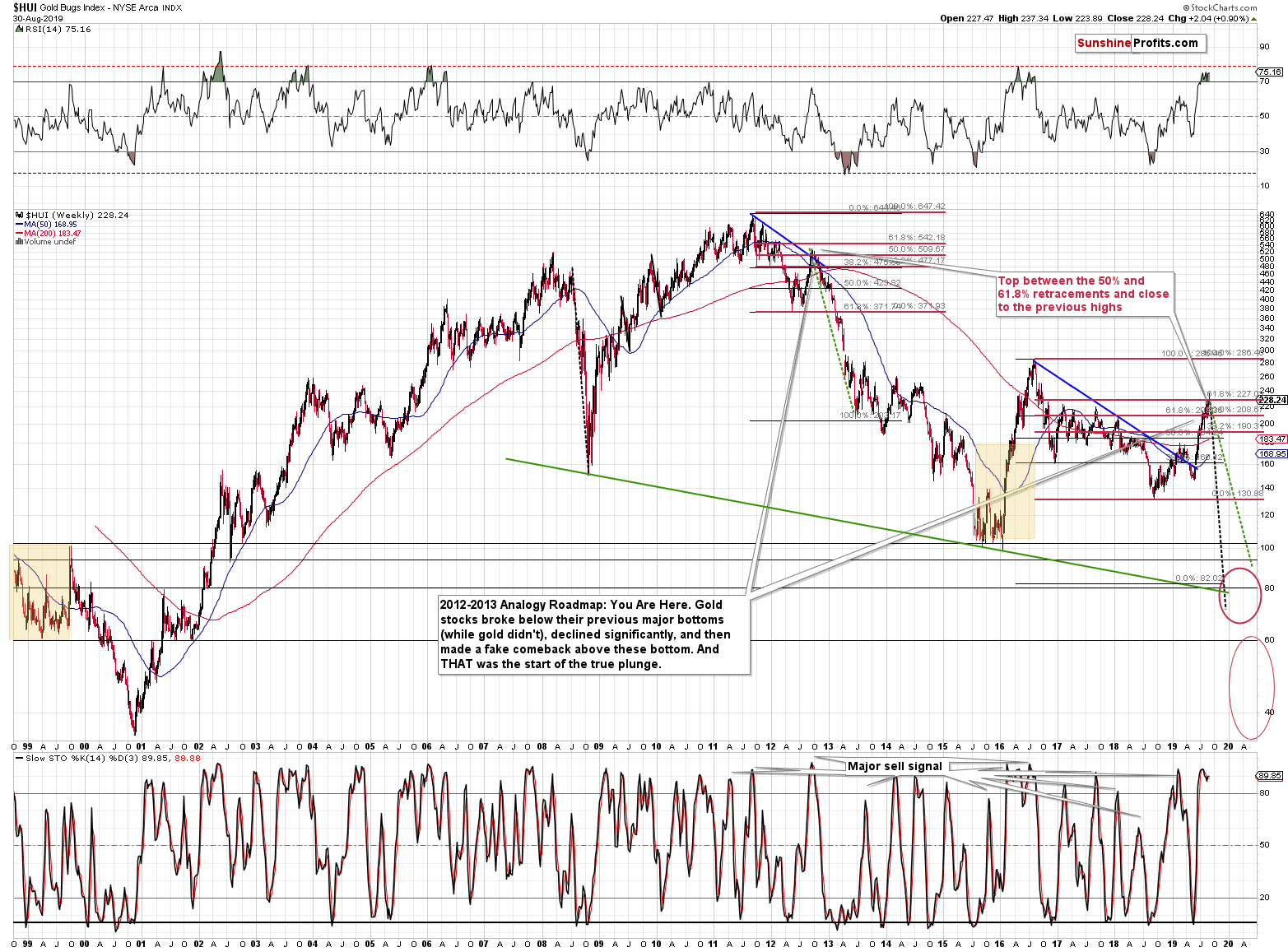Briefly: in our opinion, full (250% of the regular size of the position) speculative short position in gold, silver, and mining stocks are justified from the risk/reward point of view at the moment of publishing this Alert.
The most important development that we saw on Friday didn't materialize in gold, silver, or any other part of the precious metals sector. It happened in the USD Index. The U.S. currency soared sharply and closed at new 2019 highs, as we've been expecting it to. The move was huge, and the closing price was also the weekly close. Rallies are not bullish by themselves, but big breakouts definitely are. What does it imply for the precious metals market in the following days and weeks?
It implies that the massive decline in the precious metals sector that has been in the cards for many weeks, is likely to finally start. Let's take a look at what happened in the USD Index first.
The Key USD Index Development
We saw a breakout to new highs - there's no doubt about that. But, is the move confirmed at this point? Only confirmed moves provide very good chance of seeing a certain price move - the unconfirmed moves only provide a slight indication.
The breakout above the May high was confirmed as the USD Index closed above it for three consecutive trading days. It also closed the week above it, and the move was huge overall. All this confirms the breakout.
However, each time the USD Index broke above the previous highs this year, it then declined anyway, almost exclusively based on unexpected news. Trump wanted to get lower USD and he got it... for a while. Despite the entire year of pushing the USD lower, the latter is at fresh yearly highs, and ready to challenge the 2016 high in the following months. Still, the higher highs created a specific tendency that would also need to be clearly invalidated before people think that the USD is really moving higher.
One of the ways to show the above-mentioned tendency is to simply draw a resistance line based on the preceding highs. The green line is based on the April, May, and early August highs. It was touched on Friday, but the USD Index closed below it. From this perspective, the USD would still need to show more strength to make the bullish case more apparent. This is likely one of the reasons due to which gold declined rather insignificantly on Friday, despite the huge move up in the USD. Another reason is that the analogy to the mid-90s shows us that gold is quite likely to keep showing strength until USD's upswing becomes apparent and accepted as such. Then gold should slide and keep on declining until reaching the final bottom at price levels that seem unthinkable to many right now.
The green line is not just a regular resistance line - it's also a neck level of a quite sizable inverse head-and-shoulders pattern. As we had described it, the previous June - mid-July inverse H&S was likely to result in a move to about 99 and that's exactly what happened. The bigger pattern that includes the smaller one, implies an even higher target. The size of the head is about 3 index points (distance between the June bottom and the green line) and applying it to the level of the neck at the moment of breakout (likely about 99) provides a target of about 102.
Naturally, a pattern is not completed until the price moves below or above a certain price. In case of the above-mentioned inverse head-and-shoulders pattern, it is the neck level that is the critical place. As of Friday, there was no breakout above the green line, but that's exactly what we saw in today's pre-market trading. The breakout happened just several hours ago, and it's not confirmed by a closing price, so it's not extremely important yet, but it's definitely something worth keeping in mind. If the USD Index continues to rally here, it's likely to soar to 102 and this will make it crystal clear for everyone that the key trend for the USD Index is up. And that's when gold, and the rest of the PM sector is likely to truly plunge.
Please note that there is no strong resistance at 102, so the USD would most likely rally to 104 or so (the 2016 high) or even higher, to the rising resistance line at about 110.
But gold hasn't declined along with higher USD prices, so why should it decline now?
Because exactly the same thing happened in mid-90s.
Gold had a multi-month delay in reacting to USD's mid-90s rally. Gold rallied initially and it even moved temporarily above the previous highs at the top. But then, when USD's rally became apparent, it resumed its medium-term downtrend and kept on declining until the final bottom was reached.
Besides, just because gold didn't decline profoundly on Friday, it doesn't mean that it didn't tell us what it wants to do next.
Meanwhile in Precious Metals
Gold declined over $8 last week. These $8 are not important - what is important is how it declined. Gold moved higher early in the week and before the week was over, it erased its entire gain and then some. Consequently, gold formed a powerful reversal pattern - the shooting star candlestick. The volume that accompanied it was significant, so the pattern is valid. The sellers overwhelmed buyers and the 2011 and 2012 lows proved to be strong resistance.
Before moving to silver, we would like to quote the part of our previous analyses about the current seasonality for the gold market:
The key thing is that something special is often happening on the gold market around the U.S. Labor Day. In almost all cases, gold is either topping or already after a nearby top. In other words, it's perfectly set for a major decline in the following weeks, and sometimes, months.
6 out of the last 8 U.S. Labor Days were a great time to profit on yellow metal's medium-term price declines. There was only one bullish case (in 2018), and was one unclear (in 2015, when gold moved higher in the short run, but then declined anyway). Consequently, it appears that it's high time for gold to end its recent rally.
This analogy in terms of time as a building bridge to yet another analogy becomes obvious once you take a look at the RSI indicator in the upper part of the chart. It's currently above the 80 level. There was only one other case in the previous years when we saw something similar. It was at the 2011 top.
The 2011 top is usually just mentioned as the 2011 top, or THE top, as it was the most prominent high of the past decades, so there's no way to mistake it for a different high. Consequently, it's easy to forget when did exactly this top take place. The initial high took place on August 23, 2011, and the final (THE) top took place on September 6, 2011 (the first session after the U.S. Labor Day).
Interestingly, the August 13, 2019 session was very volatile overall, which might be similar (to a smaller extent, but still) to the initial August 2011 top.
To summarize, gold is after a sharp rally that took the RSI above 80, indicating extremely overbought conditions, and the only similar case from the recent past is the 2011 top. The 2011 decline started shortly after the U.S. Labor Day, and gold then erased over 61.8% of its most recent upswing - and very fast. It formed a temporary bottom a bit below the previous local high. Gold didn't move to its 50-day moving average at that time.
The 61.8% Fibonacci retracement of the most recent rally is at $1,318. The most recent local high is at about $1,350. The 50-day moving average is at about $1,315 right now. Consequently, applying the 2011 details to the current situation provides us with a short-term target at about $1,320.
This is where gold is likely to move next before bouncing. It's likely to then decline once again, but since no market moves up or down in a straight line, we're adjusting our exit target for the current short position to accommodate the above - we're moving them to $1,332, in order to maximize the chance of realizing the trade.
Before summarizing, please note that if we discount all the price moves surrounding the early September without looking exactly at this particular date, we get a picture in which gold might be topping right now or a one in which it has already topped.
Our gold seasonality charts show that the rally in the yellow metal might already be over. The accuracy of the prediction (i.e. the difference between the previous cases) is relatively big right now, so it's unclear whether the top is already in or not, but please note how the accuracy rises after the first part of September, along with lower predicted gold prices. This means that whenever the top forms (whether it formed yesterday, will it form on Tuesday right after the U.S. Labor Day, or anytime in between), gold is already likely to be much lower in mid-September.
Gold is extremely likely to roll over shortly and its recent hesitation to move higher after Monday's reversal confirms it.
The situation in silver and mining stocks is relatively similar from the long-term point of view as they both corrected 61.8% of their preceding 2016 - 2018 declines. Gold miners outperformed silver initially and then the roles have reversed. Silver's strength in typical for the final part of an upswing, which means that the rally has likely already ran its course.
Those that do not specialize in the precious metals market, will often view silver's strong performance in the short run as something profoundly bullish. And if this means that silver is outperforming gold (just as it did recently), this is a sell sign in disguise. It's not intuitive and it's against some rules that apply to other markets, but that's just how the precious metals market works. If you ever feel that silver is about to take off as it's been outperforming gold on a short-term basis, rallying vertically etc., or you read an analysis or watch a video that claims so, please take a look at this chart and count how many times per year - on average - gold and silver topped right after silver's short-term strength. This will help you put silver's rally into proper perspective.
The most important thing, however, is that over the long run, neither silver, nor mining stocks suggest that a new bull market had started. Neither is at new highs - they are both barely correcting the previous decline to some extent. But we elaborated on that previously, so we don't want to go into details once again here.
What we do want to emphasize, though, is the extremely bearish seasonal effect that we have in place right now. We already wrote about it below the gold chart, but it's so important right now and worth mentioning once again, especially in light of USD's strength and multiple bearish factors that still remain in place. If you haven't done so already, please examine the below links (especially those from the "critical" category) for more details of this analogy.
Key Factors to Keep in Mind
Critical factors:
- The USD Index broke above the very long-term resistance line and verified the breakout above it. Its huge upswing is already underway.
- The USD's long-term upswing is an extremely important and bearish factor for gold. There were only two similar cases in the past few decades, when USD Index was starting profound, long-term bull markets, and they were both accompanied by huge declines in gold and the rest of the precious metals market
- Out of these two similar cases, only one is very similar - the case when gold topped in February 1996. The similarity extends beyond gold's about a yearly delay in reaction to the USD's rally. Also the shape of gold price moves prior to the 1996 high and what we saw in the last couple of years is very similar, which confirm the analysis of the gold-USD link and the above-mentioned implications of USD Index's long-term breakout.
- The similarity between now and 1996 extends to silver and mining stocks - in other words, it goes beyond USD, gold-USD link, and gold itself. The white metal and its miners appear to be in a similar position as well, and the implications are particularly bearish for the miners. After their 1996 top, they erased more than 2/3rds of their prices.
- Many investors got excited by the gold-is-soaring theme in the last few months, but looking beyond the short-term moves, reveals that most of the precious metals sector didn't show substantial strength that would be really visible from the long-term perspective. Gold doesn't appear to be starting a new bull market here, but rather to be an exception from the rule.
- Gold's True Seasonality around the US Labor Day points to a big decline shortly. Moreover, it was the very first session after the 2011 U.S. Labor Day that marked THE top for gold
Very important, but not as critical factors:
- Long-term technical signs for silver, i.a. the analogy in terms of price to what we saw in 2008, shows that silver could slide even below $10.
- Silver's very long-term cycles point to a major reversal taking place right now and since the most recent move was up, the implications are bearish (this is also silver's technical sign, but it's so important that it deserves its own point)
- Long-term technical signs for gold stocks point to this not being a new gold bull market beginning. Among others, it's their long-term underperformance relative to gold that hint this is rather a corrective upswing within a bear market that is not over yet.
- Record-breaking weekly volume in gold is a strong sign pointing to lower gold prices
Important factors:
- Extreme volume reading in the SIL ETF (proxy for silver stocks) is an effective indication that lower values of silver miners are to be expected
- Silver's short-term outperformance of gold, and gold stocks' short-term underperformance of gold both confirm that the precious metals sector is topping here
- Gold topped almost right at its cyclical turning point, which makes the trend reversal more likely
- Copper broke below its head-and-shoulders pattern and confirmed the breakdown. The last time we saw something similar was in April 2013, when the entire precious metals sector was on the verge of plunging lower.
Moreover, please note that while there may be a recession threat, it doesn't mean that gold has to rally immediately. Both: recession and gold's multi-year rally could be many months away - comparing what happened to bond yields in the 90s confirms that.
All in all, the odds are that we'll see a turnaround shortly and that the precious metals market will decline in tune with the multiple factors that have been hinting at it.
Fundamentals and Gold
Before summarizing, a quick note on the fundamental part of the market. One may say that there is over $16 trillion of negative yielding corporate and government debt and gold and they can ask how can this not be good for gold. After all, this might mean that savers are being robbed of their money so that Fed can prop-up asset prices. And we agree to a certain extent. The fundamentals situation for gold is positive and it's likely to take gold to much higher prices. However, was the fundamental situation for gold great 8 years ago? Weren't the debt levels already very high? Weren't the governments and monetary authorities printing a lot of money? The debt levels were high, both: standalone, and compared to GDP. The printing presses were far from being cool and there were many other fundamental reasons for gold to rally. And yet, gold topped in 2011, and then continued to decline in the following years.
And silver - wasn't the fundamental outlook for the white metal great in March 2008? Did it worsen in the following 7 months? The silver fundamentals were great in March 2008 and they didn't change later that year. And yet, silver's price at the March 2008 top was cut in more than half later that year.
Fundamental factors drive gold in the long run, and they are the reason to expect gold and silver to soar in the following years. However, if the trend is still down - just as most of the precious metals market (silver, gold stocks, and silver stocks) and gold to silver ratio indicate, then this doesn't mean that gold will move higher based on the fundamentals shortly. It might decline - even profoundly first - and then recover, soaring back with vengeance. That's exactly what happened in 2008, for instance. The USD Index is most likely breaking out much higher here, and this is exactly the time to expect gold to plunge, not to soar. Just as it was the case in mid-90s.
Summary
Summing up, silver's outperformance and mining stocks' weakness point to lower precious metals prices in the near term and it seems that we just saw another very important short-term confirmation - weekly reversal in gold. The similarity to what happened in mid-90s remains intact, and USD's strength serves as a very strong headwind for the yellow metal. This, along with all the other medium-term factors outlined in the previous Alerts continue to point to much lower gold and silver prices in the following months. Let's keep in mind that due to gold's tendency to decline in the period following the U.S. Labor Day, it seems that we will not have to wait too long for much lower gold prices. In fact, a move to about $1,330 in gold appears quite likely in the next few weeks.
As always, we'll keep you - our subscribers - informed.
To summarize:
Trading capital (supplementary part of the portfolio; our opinion): Full speculative short position (250% of the full position) in gold, silver, and mining stocks is justified from the risk/reward perspective with the following stop-loss orders and exit profit-take price levels:
- Gold: profit-take exit price: $1,332; stop-loss: $1,603; initial target price for the DGLD ETN: $39.87; stop-loss for the DGLD ETN: $23.37
- Silver: profit-take exit price: $14.62; stop-loss: $19.13; initial target price for the DSLV ETN: $32.96; stop-loss for the DSLV ETN $16.37
- Mining stocks (price levels for the GDX ETF): profit-take exit price: $17.61; stop-loss: $33.37; initial target price for the DUST ETF: $32.28; stop-loss for the DUST ETF $5.78
In case one wants to bet on junior mining stocks' prices (we do not suggest doing so - we think senior mining stocks are more predictable in the case of short-term trades - if one wants to do it anyway, we provide the details), here are the stop-loss details and target prices:
- GDXJ ETF: profit-take exit price: $23.71; stop-loss: $48.42
- JDST ETF: profit-take exit price: $73.32 stop-loss: $9.67
Long-term capital (core part of the portfolio; our opinion): No positions (in other words: cash)
Insurance capital (core part of the portfolio; our opinion): Full position
Whether you already subscribed or not, we encourage you to find out how to make the most of our alerts and read our replies to the most common alert-and-gold-trading-related-questions.
Please note that the in the trading section we describe the situation for the day that the alert is posted. In other words, it we are writing about a speculative position, it means that it is up-to-date on the day it was posted. We are also featuring the initial target prices, so that you can decide whether keeping a position on a given day is something that is in tune with your approach (some moves are too small for medium-term traders and some might appear too big for day-traders).
Plus, you might want to read why our stop-loss orders are usually relatively far from the current price.
Please note that a full position doesn't mean using all of the capital for a given trade. You will find details on our thoughts on gold portfolio structuring in the Key Insights section on our website.
As a reminder - "initial target price" means exactly that - an "initial" one, it's not a price level at which we suggest closing positions. If this becomes the case (like it did in the previous trade) we will refer to these levels as levels of exit orders (exactly as we've done previously). Stop-loss levels, however, are naturally not "initial", but something that, in our opinion, might be entered as an order.
Since it is impossible to synchronize target prices and stop-loss levels for all the ETFs and ETNs with the main markets that we provide these levels for (gold, silver and mining stocks - the GDX ETF), the stop-loss levels and target prices for other ETNs and ETF (among other: UGLD, DGLD, USLV, DSLV, NUGT, DUST, JNUG, JDST) are provided as supplementary, and not as "final". This means that if a stop-loss or a target level is reached for any of the "additional instruments" (DGLD for instance), but not for the "main instrument" (gold in this case), we will view positions in both gold and DGLD as still open and the stop-loss for DGLD would have to be moved lower. On the other hand, if gold moves to a stop-loss level but DGLD doesn't, then we will view both positions (in gold and DGLD) as closed. In other words, since it's not possible to be 100% certain that each related instrument moves to a given level when the underlying instrument does, we can't provide levels that would be binding. The levels that we do provide are our best estimate of the levels that will correspond to the levels in the underlying assets, but it will be the underlying assets that one will need to focus on regarding the signs pointing to closing a given position or keeping it open. We might adjust the levels in the "additional instruments" without adjusting the levels in the "main instruments", which will simply mean that we have improved our estimation of these levels, not that we changed our outlook on the markets. We are already working on a tool that would update these levels on a daily basis for the most popular ETFs, ETNs and individual mining stocks.
Our preferred ways to invest in and to trade gold along with the reasoning can be found in the how to buy gold section. Additionally, our preferred ETFs and ETNs can be found in our Gold & Silver ETF Ranking.
As a reminder, Gold & Silver Trading Alerts are posted before or on each trading day (we usually post them before the opening bell, but we don't promise doing that each day). If there's anything urgent, we will send you an additional small alert before posting the main one.
=====
Latest Free Trading Alerts:
Recently, the World Gold Council published a 2019 edition of a report on gold as a strategic asset. The industry organization released later the UK edition as well. Plenty of food for thought. How can the learnings from these publications strengthen our investment decisions?
Gold as a Strategic Asset - in 2019 and Beyond
=====
Thank you.
Sincerely,
Przemyslaw Radomski, CFA
Editor-in-chief, Gold & Silver Fund Manager


